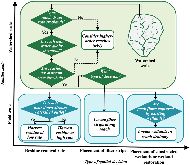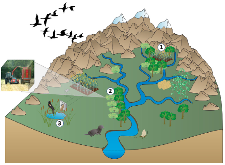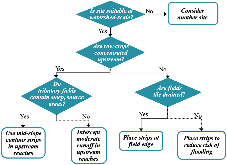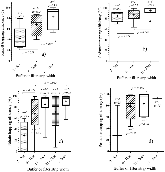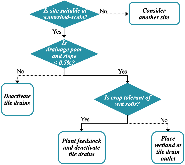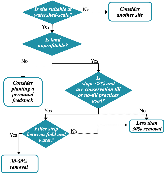|
At what spatial scale do high-quality habitats enhance the diversity of forbs and pollinators in intensively farmed landscapes?: High-quality habitats in farmed landscapes
|
journal
|
October 2007 |
|
A grassed waterway and earthen dams to control muddy floods from a cultivated catchment of the Belgian loess belt
|
journal
|
August 2008 |
|
Nitrate-Nitrogen Export: Magnitude and Patterns from Drainage Districts to Downstream River Basins
|
journal
|
November 2014 |
|
An integrated model for assessment of sustainable agricultural residue removal limits for bioenergy systems
|
journal
|
January 2013 |
|
A Review of Vegetated Buffers and a Meta-analysis of Their Mitigation Efficacy in Reducing Nonpoint Source Pollution
|
journal
|
January 2010 |
|
Pesticide contamination interception strategy and removal efficiency in forest buffer and artificial wetland in a tile-drained agricultural watershed
|
journal
|
May 2013 |
|
Multimetric spatial optimization of switchgrass plantings across a watershed
|
journal
|
January 2012 |
|
Modeling the effects of riparian buffer zone and contour strips on stream water quality
|
journal
|
August 2009 |
|
Overview: Surface flow constructed wetlands
|
journal
|
January 1995 |
|
The influence of catchment land use on stream integrity across multiple spatial scales
|
journal
|
February 1997 |
|
Water Quality Functions of Riparian Forest Buffers in Chesapeake Bay Watersheds
|
journal
|
September 1997 |
|
Sustainable agricultural residue removal for bioenergy: A spatially comprehensive US national assessment
|
journal
|
February 2013 |
|
Potential environmental effects of corn (Zea mays L.) stover removal with emphasis on soil organic matter and erosion
|
journal
|
January 2002 |
|
Multifunctional landscapes: Site characterization and field-scale design to incorporate biomass production into an agricultural system
|
journal
|
September 2015 |
|
Effectiveness of grass strips in trapping suspended sediments from runoff
|
journal
|
April 2010 |
|
Land management strategies for improving water quality in biomass production under changing climate
|
journal
|
March 2017 |
|
Wetlands in agricultural landscapes for nitrogen attenuation and biodiversity enhancement: Opportunities and limitations
|
journal
|
July 2013 |
|
A Novel Framework to Classify Marginal Land for Sustainable Biomass Feedstock Production
|
journal
|
January 2011 |
|
The use of wetlands for the control of non-point source pollution
|
journal
|
August 1995 |
|
Factors affecting nonindustrial private forest landowners' willingness to supply woody biomass for bioenergy
|
journal
|
January 2011 |
|
A Conceptual Evaluation of Sustainable Variable-Rate Agricultural Residue Removal
|
journal
|
January 2012 |
|
Environmental and Economic Trade-Offs in a Watershed When Using Corn Stover for Bioenergy
|
journal
|
February 2013 |
|
Simulating and evaluating best management practices for integrated landscape management scenarios in biofuel feedstock production: Evaluating Best Management Practices for Biofuel Feedstock Production
|
journal
|
September 2015 |
|
Targeting land-use change for nitrate-nitrogen load reductions in an agricultural watershed
|
journal
|
November 2010 |
|
Agricultural buffers at the rural–urban fringe: an examination of approval by farmers, residents, and academics in the Midwestern United States
|
journal
|
August 2004 |
|
Regional and global concerns over wetlands and water quality
|
journal
|
February 2006 |
|
Reducing Nitrogen Loading to the Gulf of Mexico from the Mississippi River Basin: Strategies to Counter a Persistent Ecological Problem
|
journal
|
January 2001 |
|
Design and Hydrologic Performance of a Tile Drainage Treatment Wetland in Minnesota, USA
|
journal
|
November 2016 |
|
Balancing corn stover harvest for biofuels with soil and water conservation
|
journal
|
July 2009 |
|
Effectiveness of Vegetative Filter Strips in Removal of Sediments from Overland Flow
|
journal
|
August 2006 |
|
Sediment Removal by Prairie Filter Strips in Row-Cropped Ephemeral Watersheds
|
journal
|
January 2012 |
|
Spatial Characterization of Riparian Buffer Effects on Sediment Loads from Watershed Systems
|
journal
|
September 2014 |
|
Simulated watershed scale impacts of corn stover removal for biofuel on hydrology and water quality: WATERSHED SCALE IMPACTS OF CORN STOVER REMOVAL
|
journal
|
September 2011 |
|
Missing the Boat: Midwest Farm Drainage and Gulf of Mexico Hypoxia
|
journal
|
June 2006 |
|
Development of integrated bioenergy production systems using precision conservation and multicriteria decision analysis techniques
|
journal
|
May 2016 |
|
Headwater Influences on Downstream Water Quality
|
journal
|
November 2007 |
|
Targeting conservation efforts in the presence of threshold effects and ecosystem linkages
|
journal
|
August 2002 |
|
Contributions of Systematic Tile Drainage to Watershed-Scale Phosphorus Transport
|
journal
|
March 2015 |
|
Growing Dedicated Energy Crops on Marginal Lands and Ecosystem Services
|
journal
|
January 2016 |
|
Water Quality in Walnut Creek Watershed: Herbicides in Soils, Subsurface Drainage, and Groundwater
|
journal
|
January 1999 |
|
Spatial Optimization of Six Conservation Practices Using Swat in Tile-Drained Agricultural Watersheds
|
journal
|
July 2015 |
|
Prairies Thrive Where Row Crops Drown: A Comparison of Yields in Upland and Lowland Topographies in the Upper Midwest US
|
journal
|
May 2016 |
|
Methods to prioritize placement of riparian buffers for improved water quality
|
journal
|
May 2008 |
|
Role of buffer strips in management of waterway pollution: A review
|
journal
|
July 1994 |
|
Opportunities for Energy Crop Production Based on Subfield Scale Distribution of Profitability
|
journal
|
October 2014 |
|
Water Quality Modeling of Fertilizer Management Impacts on Nitrate Losses in Tile Drains at the Field Scale
|
journal
|
March 2008 |
|
Switchgrass nitrogen response and estimated production costs on diverse sites
|
journal
|
April 2017 |
|
Integrated Management of In-Field, Edge-Of-Field, and After-Field Buffers
|
journal
|
February 2006 |
|
Evaluating Agricultural Best Management Practices in Tile-Drained Subwatersheds of the Mackinaw River, Illinois
|
journal
|
January 2011 |
|
Availability of corn stover as a sustainable feedstock for bioethanol production
|
journal
|
May 2003 |
|
Agricultural use of wetlands: opportunities and limitations
|
journal
|
August 2009 |
|
Navigating the Socio-Bio-Geo-Chemistry and Engineering of Nitrogen Management in Two Illinois Tile-Drained Watersheds
|
journal
|
March 2015 |
|
Subfield profitability analysis reveals an economic case for cropland diversification
|
journal
|
January 2016 |
|
Spatial identification and optimization of upland wetlands in agricultural watersheds
|
journal
|
March 2013 |
|
Field-Level Financial Assessment of Contour Prairie Strips for Enhancement of Environmental Quality
|
journal
|
June 2013 |
|
A design aid for determining width of filter strips
|
journal
|
July 2008 |
|
Soil erosion hazard maps for corn stover management using National Resources Inventory data and the Water Erosion Prediction Project
|
journal
|
July 2010 |
|
Nitrate Leaching to Subsurface Drains as Affected by Drain Spacing and Changes in Crop Production System
|
journal
|
January 2004 |
|
Multi-user quality of floral services along a gradient of margin habitats between semi-natural grasslands and forests
|
journal
|
May 2018 |
|
Changes in Long-Term No-Till Corn Growth and Yield under Different Rates of Stover Mulch
|
journal
|
July 2006 |
|
Farmer willingness to grow switchgrass for energy production
|
journal
|
November 2007 |
|
The Effect of Landscape Position on Biomass Crop Yield
|
journal
|
January 2010 |
|
Combining bioenergy and nature conservation: An example in wetlands
|
journal
|
September 2019 |
|
Nitrate loss in subsurface drainage and corn yield as affected by timing of sidedress nitrogen
|
journal
|
December 2013 |
|
Comparison of Targeted Replacement and Vegetative Filter Strips for Sediment Control and Cost Effectiveness
|
journal
|
September 2009 |
|
Major Factors Influencing the Efficacy of Vegetated Buffers on Sediment Trapping: A Review and Analysis
|
journal
|
September 2008 |
|
Strategic use of native species on environmental gradients increases diversity and biomass relative to switchgrass monocultures
|
journal
|
January 2016 |
|
Economic assessment of landowners' willingness to supply energy crops on marginal lands in the northeastern of the United States
|
journal
|
June 2018 |
|
Relationships between Landscape Pattern, Wetland Characteristics, and Water Quality in Agricultural Catchments
|
journal
|
November 2008 |
|
Biomass yield from planted mixtures and monocultures of native prairie vegetation across a heterogeneous farm landscape
|
journal
|
March 2014 |
|
Excessive rainfall leads to maize yield loss of a comparable magnitude to extreme drought in the United States
|
journal
|
April 2019 |
